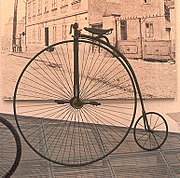Several innovators contributed to the history of the bicycle by developing precursor human-powered vehicles, including the velocipede, invented in 1763 in France by Pierre Lallement. The documented ancestors of today's modern bicycle were known as pushbikes, Draisines or hobby horses. To use the Draisine, first introduced to the public in Paris by the German Baron Karl von Drais in 1818[3], the operator sat astride a wooden frame supported by two in-line wheels and pushed the vehicle along with his/her feet while steering the front wheel.

Scottish blacksmith Kirkpatrick MacMillan refined this in 1839 by adding a mechanical crank drive to the rear wheel, thus creating the first true "bicycle" in the modern sense. In the 1850s and 1860s, Frenchmen Pierre Michaux and Pierre Lallement took bicycle design in a different direction, placing the pedals on an enlarged front wheel. Their creation, of wrought iron and wood, developed into the "penny-farthing" (more formally an ordinary bicycle), featuring a tubular steel frame on which were mounted wire spoked wheels with solid rubber tires. These bicycles were not, however, for the faint hearted, due to the very high seat and poor weight distribution.
The subsequent dwarf ordinary addressed some of these faults by reducing the front wheel diameter and setting the seat further back, necessitating the addition of gearing, effected in a variety of ways, to attain sufficient speed. However, having to both pedal and steer via the front wheel remained a problem. Starley's nephew, J. K. Starley, J. H. Lawson, and Shergold solved this problem by introducing the chain drive connecting the pedals held with the frame to the back wheel. These models were known as dwarf safeties, or safety bicycles, for their lower seat height and better weight distribution. Starley's 1885 Rover is usually described as the first recognizably modern bicycle. Soon, the seat tube was added, creating the double-triangle diamond frame of the modern bike.

New innovations increased comfort, and ushered in a second bicycle craze, the 1890s' Golden Age of Bicycles. In 1888, Scotsman John Boyd Dunlop introduced the pneumatic tire, which soon became universal. Soon after, the rear freewheel was developed, enabling the rider to coast without the pedals spinning out of control. This refinement led to the 1898 invention of coaster brakes. Derailleur gears and hand-operated cable-pull brakes were also developed during these years, but were only slowly adopted by casual riders. By the turn of the century, cycling clubs flourished on both sides of the Atlantic, and touring and racing were soon extremely popular.
Bicycles and horse buggies were the two mainstays of private transportation just prior to the automobile, and the grading of smooth roads in the late 19th century was stimulated by the wide use of these devices.

No comments:
Post a Comment